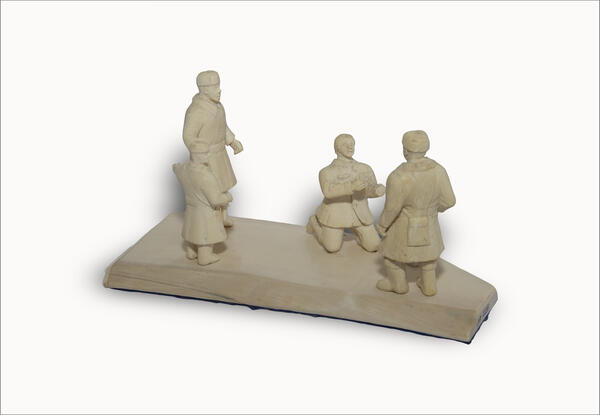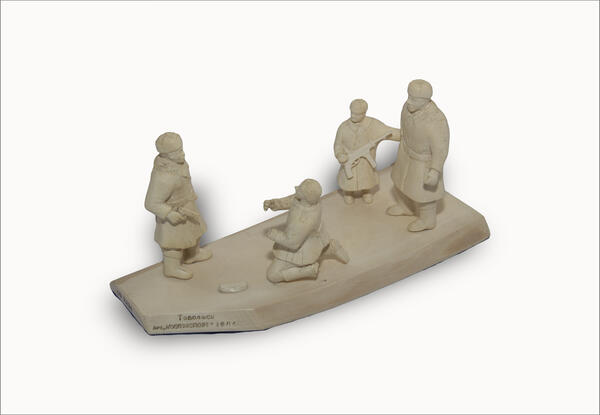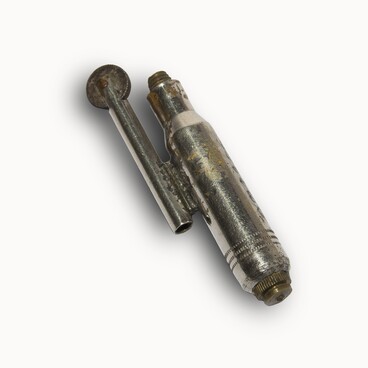The town of Tobolsk is one of the main centers of bone carving in Russia. The unique works of Tobolsk craftsmen are often exhibited at international exhibitions and displayed at museums such as the State Hermitage and the State Russian Museum. Many tourists bring back carved bone statues as a souvenir from Tobolsk.
Each product is made by hand, it is unique and one of a kind. Bone carving artists depict various historical events, including those related to wars. With their statues, they express their gratitude for the courage and heroic deeds of battle participants.
As a result, the memory of the victims and tragic events of World War II is treasured not only in the thoughts and hearts of the participants of those events and their descendants but also in the cultural heritage.
In this group statue, the sculptor showed a common wartime situation — the interrogation of a prisoner. During a military operation, troops often tried to capture an enemy soldier with the special purpose of obtaining information about the enemy.
By interrogating the prisoner, they usually attempted to find out the number and composition of the enemy’s troops, their whereabouts, further plans, as well as the specifics of military operations. Moreover, they tried to analyze the numbering of military units as well as unidentified objects on the map.
During the Great Patriotic War, even those who were not intelligence officers sometimes helped to capture prisoners. Technological advances have significantly reduced the need for a prisoner as a source of information, but capturing a prisoner is still a mandatory item in the combat training program of all ground forces.
The craftsman placed the multi-figure composition on a pentagonal stand. In the center of the composition is a prisoner standing on his knees, behind him is a soldier with a pistol. In front of the prisoner are two soldiers conducting the interrogation.
An inscription was engraved on the end plates, helping to identify that the statue was created in 1946. It was made by Alexey Iosifovich Bizin, a craftsman from the “Koopeksport” artel in Tobolsk.
Each product is made by hand, it is unique and one of a kind. Bone carving artists depict various historical events, including those related to wars. With their statues, they express their gratitude for the courage and heroic deeds of battle participants.
As a result, the memory of the victims and tragic events of World War II is treasured not only in the thoughts and hearts of the participants of those events and their descendants but also in the cultural heritage.
In this group statue, the sculptor showed a common wartime situation — the interrogation of a prisoner. During a military operation, troops often tried to capture an enemy soldier with the special purpose of obtaining information about the enemy.
By interrogating the prisoner, they usually attempted to find out the number and composition of the enemy’s troops, their whereabouts, further plans, as well as the specifics of military operations. Moreover, they tried to analyze the numbering of military units as well as unidentified objects on the map.
During the Great Patriotic War, even those who were not intelligence officers sometimes helped to capture prisoners. Technological advances have significantly reduced the need for a prisoner as a source of information, but capturing a prisoner is still a mandatory item in the combat training program of all ground forces.
The craftsman placed the multi-figure composition on a pentagonal stand. In the center of the composition is a prisoner standing on his knees, behind him is a soldier with a pistol. In front of the prisoner are two soldiers conducting the interrogation.
An inscription was engraved on the end plates, helping to identify that the statue was created in 1946. It was made by Alexey Iosifovich Bizin, a craftsman from the “Koopeksport” artel in Tobolsk.





